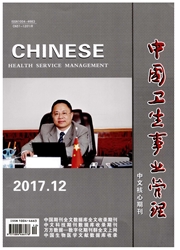

 中文摘要:
中文摘要:
目的:调查四川省基层医疗卫生服务机构的举办主体、卫生资源的配置情况及基本公共卫生服务的补助情况,发现其存在的问题,为进一步开展基层卫生服务工作提供依据.方法采用多阶段抽样的方法,在四川省随机抽取三个城市,再采用分层抽样(市、区/县、镇)方法从每个市中抽取7 ~12个社区卫生服务中心或乡镇卫生院,最终确定调查地点为26个医疗卫生服务机构.采用整群抽样方法,调查社区卫生服务中心卫生人员1044人,乡镇卫生院卫生人员447人,共计1491人.结果26家医疗卫生服务机构中,有21 (80.8%)家属政府办,5(19.2%)家属医院下设;有46.2%(12家)机构临床科室设置还不齐全,84.6%(22家)的机构预防保健科室设置齐全,50%(13家)的机构医技科室设置不全;建筑总面积为82491m 2,平均3172.7m2;社区卫生服务中心的正式人员占46.7%,临聘人员占52.3%;乡镇卫生院的正式人员占64.2%,临聘人员占35.8%;基层卫生人员中硕士学历只占0.6%,其次为本科学历,占16.5%,大专和中专人员相对较多.结论四川省基层医疗卫生服务已初具规模,但仍存在不完善的地方,政府需加大投入、完善相关政策、合理配置卫生资源.
 英文摘要:
英文摘要:
Objective To investigate the organizing body, the configuration of health resources and basic public health serv- ices, grants of primary health care institutions in Sichuan province, and findits problems in order to provide evidence for further ur- ban community health services. Methods A multi-stage sampling method is adapted to randomly select three cities in Sichuan Prov- ince, Chengdu , Neijiang, Nanchong perspectively, then using stratified sampling ( city, district/county, town ) method to extract from each city 7 to 12 community health service center or township hospitals, and ultimately determine survey sites as 26 medical and health services. Of 1044 health personnel in community health service centers,rid7 health personnel in township hospitals, and 1521 people totally are surveyed by a cluster sampling method. Results Of 21 (80.8%) families of government-run, five ( 19.2% ) family consists of hospitals in 26 medical and health services. The46.2% (12) institutions are not complete institutional clinical departments ,84.6% (22) preventive health care institutions departments are set up completely, and 50% (13) of the institutions set up medical departments insufficiently. Total construction areas are 82491m2 ,3172.7m2 on average. The official personnel ac- counts for 46.7% in community health service centers,52.3% of temporary recruits,whereas official staff accounts for 64.2% in township hospitals,35.8% of temporary recruits. Masterg degree in primary health centers are only 0.6% ,followed by undergradu- ate degreewith 16.5%. College and secondary school personnel are relatively high. Conclusion The primary health care has been build roughly in Sichuan, but there are still imperfections. The governments need to increase investment, revise relevant policies and allocate the health resources rationally.
 同期刊论文项目
同期刊论文项目
 同项目期刊论文
同项目期刊论文
 期刊信息
期刊信息
